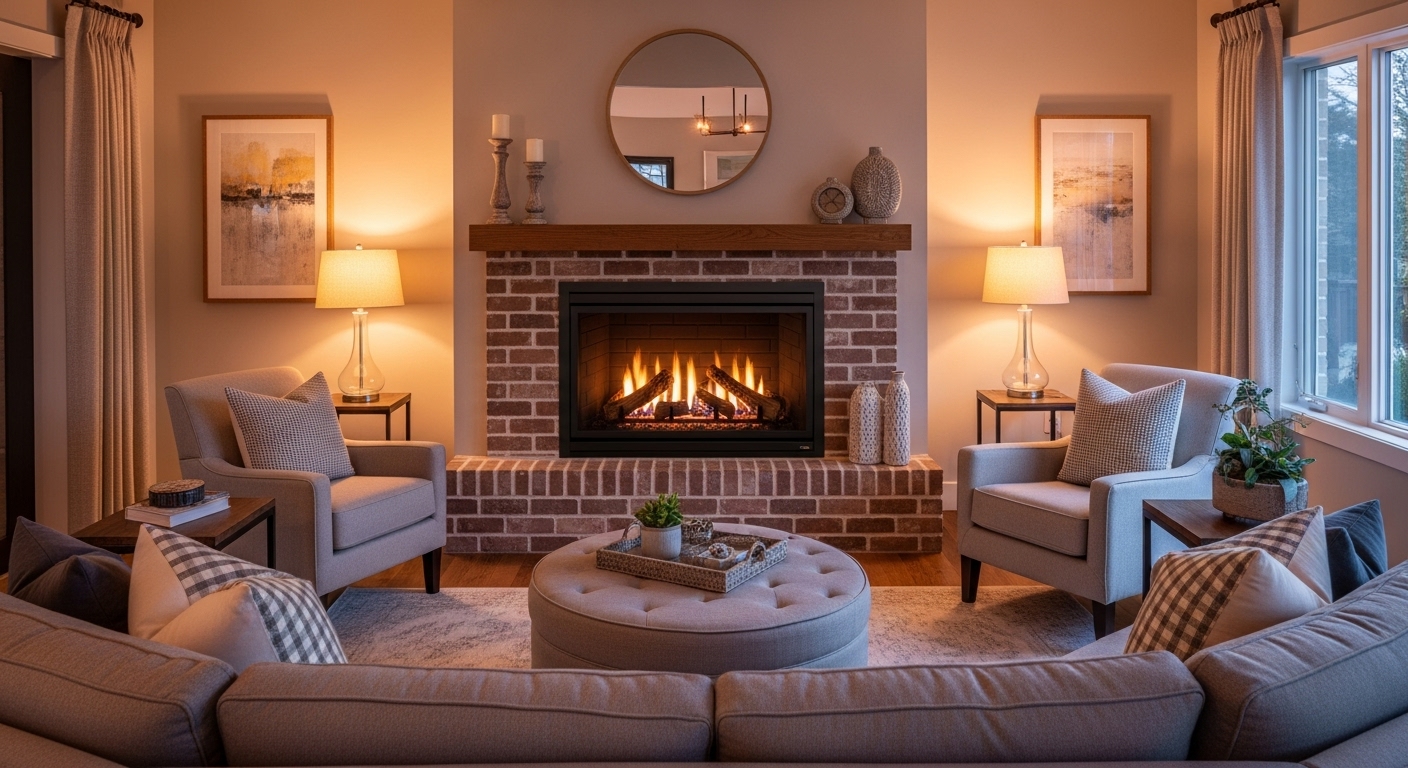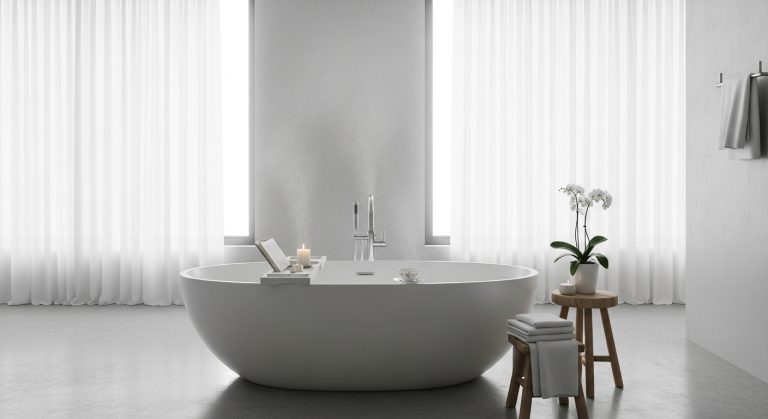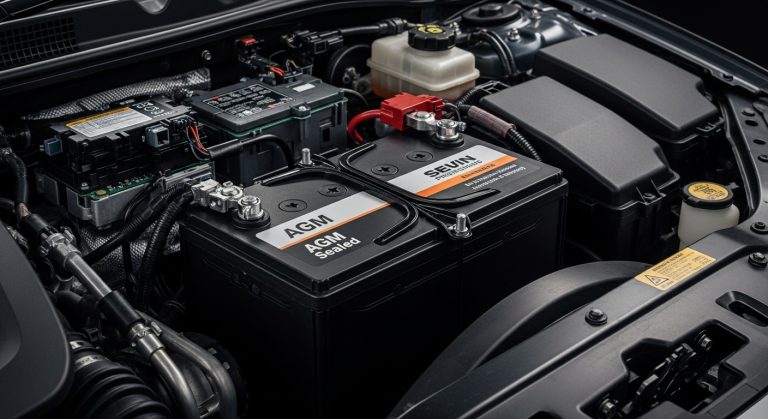Best Fireplace Gas Insert: Complete Guide for 2026
Transform your cold, drafty fireplace into a powerful heating powerhouse with the right gas insert. Say goodbye to messy wood splitting and hello to instant warmth at the flip of a switch.
The best fireplace gas inserts combine high-efficiency heating with realistic flame effects, offering BTU outputs ranging from 20,000 to 40,000 for optimal home comfort. Top models feature advanced venting systems, remote controls, and ceramic logs that create an authentic wood-burning appearance.
This comprehensive guide reveals everything you need to know about selecting the perfect gas insert for your home. From understanding different venting options to exploring key features that matter most, you’ll discover how to make an informed decision that keeps your family warm for years.
Key Takeaways
- Gas fireplace inserts provide high-efficiency heating and transform existing fireplaces into powerful, convenient heat sources with realistic flame effects.
- Direct vent inserts are the most popular and safest option, offering sealed combustion and flexible installation for most homes.
- Key features to look for include BTU output, flame realism, remote controls, and advanced safety systems like oxygen depletion sensors and automatic shut-offs.
- Professional installation is highly recommended to ensure proper venting, gas line connection, and compliance with safety codes.
- Top brands like Napoleon, Regency, and Mendota lead the market with innovative designs, while budget-friendly options are available from Pleasant Hearth and Duluth Forge.
- Regular maintenance and annual professional cleaning are essential for safe operation and long-lasting performance.
- Gas inserts deliver significant energy savings and cleaner operation compared to wood-burning fireplaces, making them an eco-friendly and cost-effective choice for modern homes.
What Is a Gas Fireplace Insert?
A gas fireplace insert is a self-contained heating unit designed to fit directly into your existing masonry fireplace. Unlike traditional wood-burning fireplaces that lose most heat up the chimney, gas inserts are engineered for maximum efficiency and convenience.
These units consist of a firebox, burner system, and realistic-looking logs or stones. The insert slides into your current fireplace opening and connects to your home’s gas line. Most models include a blower system that circulates warm air throughout the room.
How Gas Inserts Work?
Gas inserts operate through a simple combustion process. Natural gas or propane flows through specially designed burners beneath ceramic logs or decorative media. When ignited, the flames heat the firebox and surrounding air.
A built-in fan system draws cool room air into the unit, heats it, and pushes the warm air back into your living space. This forced-air circulation dramatically improves heating efficiency compared to traditional fireplaces.
Benefits Over Traditional Fireplaces
Gas inserts offer numerous advantages over wood-burning fireplaces. Convenience tops the list – no more hauling wood, cleaning ashes, or struggling with kindling. Simply press a button or flip a switch for instant flames.
Energy efficiency represents another major benefit. While traditional fireplaces lose 80-90% of heat up the chimney, gas inserts achieve efficiency ratings of 70-85%. This translates to lower heating bills and better home comfort.
Safety improvements include sealed combustion systems that prevent dangerous gases from entering your home. Many models feature automatic shut-off valves and oxygen depletion sensors for added protection.
Types of Gas Fireplace Inserts
Understanding the different types of gas inserts helps you choose the best option for your specific situation. Each type offers unique advantages depending on your home’s configuration and heating needs.
Direct Vent Gas Inserts
Direct vent inserts are the most popular choice for good reason. These units draw combustion air from outside through a special venting system and exhaust gases directly outdoors. This design eliminates the need for a traditional chimney draft.
The venting system consists of two pipes – one inside the other. The inner pipe carries exhaust gases out, while the outer pipe brings fresh air in. This sealed system ensures maximum safety and efficiency.
Direct vent inserts work well in most homes and can be installed in existing fireplaces with minimal modifications. They’re particularly suitable for tightly sealed homes where indoor air quality is a concern.
Ventless Gas Inserts
Ventless or vent-free inserts burn so cleanly that they don’t require any external venting. These units are designed with advanced burner technology that achieves complete combustion, producing only water vapor and carbon dioxide.
The main advantage is installation flexibility. Since no venting is required, ventless inserts can be installed in locations where venting isn’t practical. They also provide 100% heating efficiency since no heat escapes through vents.
However, ventless inserts aren’t legal in all areas. Some states and municipalities have restrictions due to indoor air quality concerns. Always check local codes before considering a ventless option.
Natural Vent Gas Inserts
Natural vent inserts, also called B-vent units, use your existing chimney for venting. These inserts rely on natural draft to draw combustion air from the room and exhaust gases up the chimney.
While less efficient than direct vent models, natural vent inserts cost less to install if you have a suitable existing chimney. They work best in homes with good natural draft and adequate indoor air supply.
The main drawback is lower efficiency – typically 60-70% compared to 80%+ for direct vent models. They also require more indoor air for combustion, which can create drafts in some homes.
Key Features to Consider
Selecting the right gas insert requires understanding essential features that impact performance, convenience, and long-term satisfaction. These key characteristics separate good inserts from great ones.
BTU Output and Heating Capacity
BTU (British Thermal Unit) output determines how much heat your insert produces. Proper sizing is crucial – too small won’t heat effectively, while oversized units cycle on and off frequently, reducing efficiency.
Most residential gas inserts range from 20,000 to 40,000 BTUs. A general rule suggests 20-30 BTUs per square foot for well-insulated homes. However, factors like ceiling height, insulation quality, and climate affect actual requirements.
Consider your primary heating goals. If you want supplemental heat for one room, a smaller unit may suffice. For whole-house heating or large spaces, choose higher BTU models with powerful blower systems.
Flame Appearance and Realism
Modern gas inserts create surprisingly realistic flame patterns that closely mimic wood-burning fires. Advanced burner designs produce tall, dancing flames with natural color variations from blue to yellow-orange.
Log sets have evolved dramatically in recent years. Ceramic fiber logs offer the most realistic appearance, with detailed bark textures and natural coloring. Some manufacturers even include glowing embers and charred log effects.
Consider your aesthetic preferences carefully. Some people prefer contemporary glass media or river rocks instead of traditional logs. Many inserts allow you to customize the decorative media to match your style.
Control Options and Convenience
Remote control operation has become standard on quality gas inserts. Look for remotes that control flame height, blower speed, and timer functions. Some advanced models offer smartphone app connectivity for ultimate convenience.
Thermostat compatibility allows your insert to maintain consistent room temperature automatically. The unit cycles on and off based on your temperature settings, providing hands-free operation and optimal comfort.
Manual controls should be easily accessible and intuitive to use. Look for clearly labeled switches and controls that family members can operate safely and confidently.
Safety Features
Modern gas inserts include multiple safety systems to protect your family. Oxygen depletion sensors automatically shut off gas flow if oxygen levels drop too low. This feature is especially important for ventless models.
Flame failure devices detect when the pilot light or main burner goes out unexpectedly. These sensors immediately stop gas flow to prevent dangerous accumulation. Automatic shut-off valves provide additional protection during power outages.
Cool-touch glass and safety screens prevent accidental burns. Look for inserts with tempered glass doors that remain relatively cool during operation, especially important for families with children.
Installation Requirements
Proper installation is critical for safety and optimal performance. Understanding installation requirements helps you plan your project and budget accordingly.
Chimney and Venting Considerations
Your existing chimney condition significantly impacts installation options. Professional inspection is essential to determine if your chimney can safely accommodate a gas insert. Issues like damaged flue liners or structural problems must be addressed first.
Direct vent inserts require new venting systems that typically run up through the existing chimney. The installer will line your chimney with appropriate venting materials sized for your specific insert model.
Clearance requirements vary by manufacturer and model. Most inserts need specific distances from combustible materials like wood framing or mantels. Professional measurement ensures compliance with safety codes.
Electrical and Gas Connections
Gas inserts require both gas line connections and electrical power for blowers and controls. Your existing gas line may need upgrading to handle the insert’s BTU requirements. A qualified gas technician should evaluate your current system.
Electrical requirements are typically minimal – most inserts use standard 110-volt household current. However, you’ll need a dedicated outlet near the fireplace. GFCI protection may be required depending on local codes.
Professional installation ensures all connections meet local building codes and manufacturer specifications. Improper installation can create safety hazards and void equipment warranties.
Professional vs DIY Installation
While some homeowners consider DIY installation, gas inserts require specialized knowledge and tools. Gas line work, venting installation, and electrical connections involve safety-critical components that demand professional expertise.
Licensed contractors carry insurance and understand local building codes. They can obtain necessary permits and arrange required inspections. Professional installation also ensures your insert operates safely and efficiently from day one.
The cost of professional installation typically ranges from several hundred to a few thousand dollars, depending on complexity. This investment provides peace of mind and protects your family’s safety.
Top Brands and Models
Several manufacturers dominate the gas insert market with proven track records of quality and reliability. Understanding leading brands helps narrow your selection to trusted options.
Premium Brand Options
Napoleon stands out for innovative design and advanced features. Their gas inserts feature patented burner systems that create exceptionally realistic flames. Many models include smartphone connectivity and advanced remote controls.
Regency focuses on high-efficiency heating with sleek contemporary designs. Their inserts often achieve efficiency ratings above 80% while maintaining attractive flame presentations. The brand offers extensive customization options for different home styles.
Mendota specializes in luxury gas inserts with premium materials and craftsmanship. Their units feature heavy-duty construction and sophisticated control systems. Many models include unique flame technologies that create distinctive fire patterns.
Mid-Range Quality Choices
Majestic offers excellent value with reliable performance and attractive designs. Their gas inserts include essential features like remote controls and efficient heating systems without premium pricing. The brand provides good customer support and parts availability.
Monessen focuses on traditional styling with modern efficiency. Their inserts often feature classic log sets and conventional flame patterns that appeal to homeowners seeking timeless designs. Build quality remains solid across their product line.
Superior provides dependable heating solutions with straightforward operation. Their gas inserts emphasize practical functionality over advanced features, making them suitable for homeowners who prioritize simplicity and reliability.
Budget-Friendly Alternatives
Pleasant Hearth offers basic gas inserts at accessible price points. While lacking premium features, these units provide reliable heating and attractive flame presentations. They’re suitable for homeowners with straightforward heating needs.
Duluth Forge specializes in value-oriented gas inserts with essential features. Their models include remote controls and decent efficiency ratings while maintaining competitive pricing. Build quality is adequate for typical residential use.
ProCom focuses on simple, dependable gas inserts without unnecessary complexity. Their units provide basic heating functionality with standard safety features. These inserts work well for budget-conscious homeowners seeking reliable supplemental heat.
Maintenance and Care
Proper maintenance ensures your gas insert operates safely and efficiently for many years. Regular care prevents problems and maintains optimal performance throughout the heating season.
Regular Cleaning Tasks
Annual professional cleaning is essential for safe operation. Certified technicians clean the burner system, inspect gas connections, and verify proper venting. This service typically includes checking safety systems and adjusting flame patterns.
Homeowners can perform basic maintenance between professional services. Glass door cleaning improves flame visibility and overall appearance. Use appropriate glass cleaners designed for high-temperature applications.
Dust accumulation on decorative logs and interior surfaces reduces heating efficiency. Gentle vacuuming with soft brush attachments removes debris without damaging delicate components. Always ensure the unit is completely cool before cleaning.
Seasonal Preparation
Pre-season inspection helps identify potential issues before heavy use begins. Check for animal nests, debris, or damage to exterior venting components. Clear any obstructions that could affect proper operation.
Test all control functions including remote controls, thermostats, and safety systems. Replace batteries in remote controls and carbon monoxide detectors. Verify that pilot lights ignite properly and flames appear normal.
End-of-season shutdown involves turning off gas supply valves and cleaning glass doors thoroughly. Cover exterior vents if recommended by your manufacturer to prevent weather damage during off-season months.
Troubleshooting Common Issues
Flame appearance problems often indicate burner adjustment needs. Yellow or orange flames may suggest improper air mixture or dirty burners. Contact a qualified technician for burner cleaning and adjustment.
Blower noise can result from dust accumulation or worn bearings. Regular cleaning often resolves minor noise issues. Persistent problems may require professional bearing replacement or motor service.
Remote control malfunctions usually involve battery replacement or signal interference. Check battery levels first, then verify clear line-of-sight between remote and receiver. Electronic interference from other devices can sometimes cause control problems.
Energy Efficiency and Cost Savings
Modern gas inserts deliver impressive energy efficiency that translates to real savings on heating bills. Understanding efficiency ratings and operating costs helps you maximize your investment.
Understanding Efficiency Ratings
Annual Fuel Utilization Efficiency (AFUE) measures how effectively gas inserts convert fuel into usable heat. Ratings above 75% indicate high-efficiency units that waste minimal energy. The best models achieve ratings of 80-85%.
Efficiency depends on several factors including venting type and installation quality. Direct vent models typically achieve higher efficiency than natural vent units. Proper installation and regular maintenance maintain peak efficiency levels.
Sealed combustion systems contribute significantly to efficiency by eliminating heated indoor air loss. These systems draw combustion air from outside, preventing conditioned air from being pulled up the chimney.
Operating Cost Comparisons
Gas inserts typically cost significantly less to operate than electric heating systems. Natural gas prices remain relatively stable compared to electricity, providing predictable heating costs throughout the season.
Compared to wood-burning fireplaces, gas inserts offer dramatic cost advantages. No firewood purchases, chimney cleaning, or ash disposal expenses. The convenience factor alone justifies the switch for many homeowners.
Zoned heating capabilities allow you to heat specific areas while reducing whole-house heating needs. This targeted approach can lower overall energy consumption, especially in homes with unused rooms.
Environmental Impact
Modern gas inserts burn much cleaner than wood-burning fireplaces. They produce minimal particulate emissions and don’t contribute to local air quality problems. This clean burning makes them suitable for areas with strict emission regulations.
Natural gas combustion produces fewer greenhouse gases per BTU than many other heating fuels. When sourced responsibly, natural gas represents a relatively clean heating option compared to oil or propane.
Improved home heating efficiency reduces overall energy consumption and environmental impact. High-efficiency gas inserts help homeowners reduce their carbon footprint while maintaining comfortable living spaces.
Frequently Asked Questions
How long do gas fireplace inserts typically last?
Quality gas inserts can provide 15-20 years of reliable service with proper maintenance. The firebox and burner systems are built to withstand high temperatures and frequent use.
Regular professional maintenance significantly extends insert lifespan. Annual cleaning and inspection prevent small issues from becoming major problems. Replacing worn components like thermocouples and control valves keeps units operating efficiently.
Usage patterns also affect longevity. Inserts used as primary heating sources may require more frequent maintenance than those used occasionally. However, even heavily used units can last decades with appropriate care.
Can I install a gas insert in any fireplace?
Most masonry fireplaces can accommodate gas inserts with proper modifications. However, prefabricated or zero-clearance fireplaces may have restrictions that limit insert options.
Professional evaluation is essential to determine compatibility. Factors like fireplace size, chimney condition, and local building codes affect installation feasibility. Some older fireplaces may require structural modifications.
Venting requirements vary by insert type and existing chimney configuration. Direct vent models offer the most flexibility, while natural vent units depend on adequate chimney draft. A qualified installer can assess your specific situation.
Do gas inserts require electricity to operate?
Most gas inserts need electricity for blower fans and electronic controls. However, many models include battery backup systems that allow basic operation during power outages.
Pilot light systems can operate without electricity, providing heat even when power is unavailable. The blower fan won’t work, but radiant heat from the firebox still provides warmth.
Millivolt systems use thermocouple-generated electricity to operate gas valves and controls. These systems provide greater power outage reliability but may have limited control features compared to electronic systems.
What’s the difference between natural gas and propane inserts?
Fuel type compatibility is determined during manufacturing. Most inserts are designed for either natural gas or propane, though some models offer conversion kits for switching between fuels.
BTU output may vary slightly between natural gas and propane versions of the same model. Propane typically provides slightly higher heat output per unit of fuel consumed.
Installation requirements differ mainly in gas line specifications and pressure regulators. Propane systems require storage tanks and different safety considerations compared to natural gas connections.
How much does it cost to run a gas insert?
Operating costs depend on local gas prices, insert efficiency, and usage patterns. Most homeowners spend between \$200-600 annually on gas for supplemental heating use.
Efficiency ratings significantly impact operating costs. High-efficiency models convert more fuel into usable heat, reducing overall consumption. A 20% efficiency improvement can save hundreds of dollars annually.
Usage patterns greatly influence costs. Using the insert as primary heat for specific rooms costs more than occasional use for ambiance. Thermostat controls help optimize efficiency and minimize unnecessary operation.
Transform Your Home with the Perfect Gas Insert
The best fireplace gas insert transforms your cold, inefficient fireplace into a powerful heating solution that combines comfort, convenience, and style. With efficiency ratings reaching 85% and BTU outputs up to 40,000, today’s gas inserts deliver serious heating performance while creating beautiful flame displays that rival traditional wood fires.
Your investment in a quality gas insert pays dividends through lower heating bills, increased home comfort, and enhanced property value. The convenience of instant heat at the touch of a button, combined with minimal maintenance requirements, makes gas inserts the smart choice for modern homeowners.
Take action today and start enjoying the warmth, beauty, and efficiency of a premium gas insert. Your family deserves the comfort and convenience that only the best gas fireplace insert can provide.















